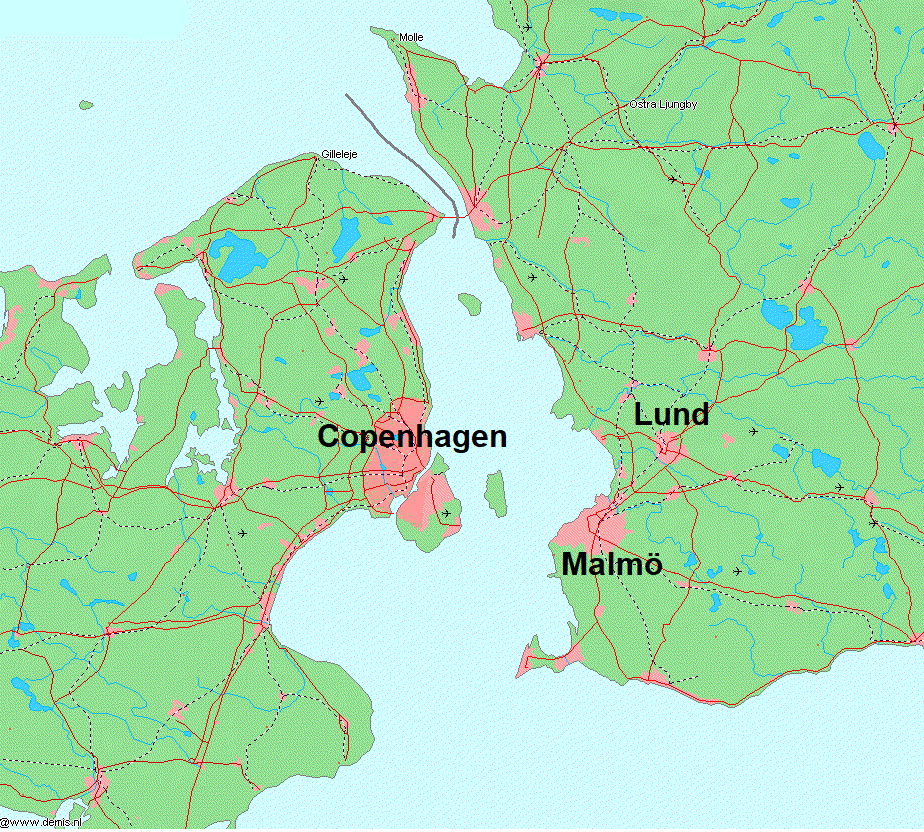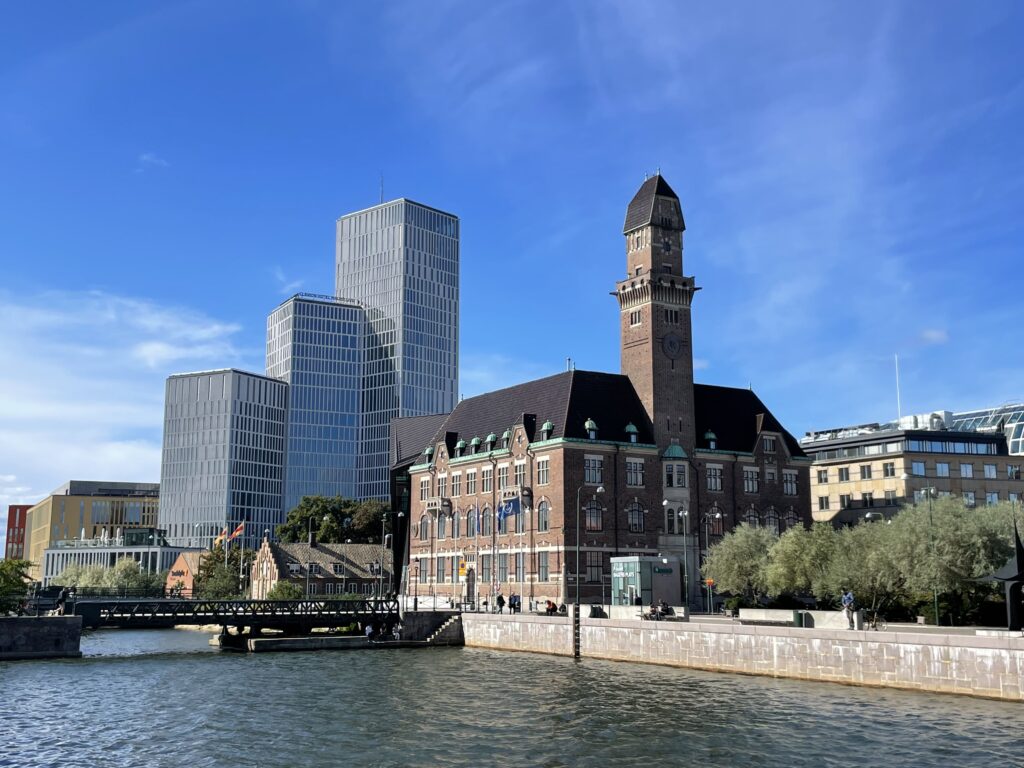Copenhagen is a city filled with famous landmarks and interesting attractions, and a tourist could easily spend multiple days visiting it. However, just crossing to the other side of the Øresund strait, the Swedish cities of Malmö and Lund offer many more fascinating sights, and can be visited together in a single day trip from Copenhagen.
Copenhagen is directly connected with Malmö via the Øresund Bridge, a fixed link between Denmark and Sweden composed of a bridge and a tunnel. Trains run very frequently between the two cities, with even four of five connections every hour, and a trip takes about 40 minutes. The bridge also features a motorway, and driving from one city to the other takes around 45 minutes. Buses are cheaper than trains or driving, but take longer, about one hour.
Lund is located 15 kilometers northeast of Malmö, and can be reached in less than 15 minutes by train from the Malmö Central Station. Trains run between the two cities every 5 to 10 minutes for most of the day. The trains crossing the Øresund Bridge from Copenhagen also continue to Lund and then other Swedish cities, so there is no need to change in Malmö when going back to the Danish capital. Driving between Malmö and Lund or taking a bus could take 20 to 30 minutes, depending on the traffic. So, trains are the easiest and fastest way to travel between Copenhagen, Malmö, and Lund.

Position of Copenhagen, Malmö, and Lund.
Malmö
Malmö is the third largest city in Sweden, after Stockholm and Gothenburg, and one of the main industrial and economic centers of the country, located in the historic region of Scania. Founded in the Late Middle Ages, the city was ruled by Denmark for centuries, and was one of the most important marketplaces in Northern Europe. Malmö became part of Sweden in the 17th century, and later developed as an industrial hub. Since the 2000s, some of the former industrial areas of the city have been redeveloped.
One of these neighborhoods is Västra Hamnen, which is located just west of the central station, and is now the most expensive and exclusive area in Malmö. Västra Hamnen hosts one of the main attractions of the city, the Turning Torso skyscraper. Completed in 2005, this was the tallest building in the Nordic countries until 2022. Close to this skyscraper is the seafront promenade where you can enjoy a view on the Øresund strait.

Turning Torso in Malmö.
After crossing a large seaside park to the south, you can reach the Malmö Castle. This historic fortress was built by the Danes during the 16th century, and now it hosts a rich museum with exhibitions on contemporary art and local history. Buying a ticket to visit the castle also allows you to visit the nearby Technology and Maritime Museum. This museum is dedicated to science and technology, and features several historic vehicles, including a submarine which you can enter.
The castle is surrounded by a beautiful park crossed by canals, and just to the east of it is the old town of Malmö. Walking along the canal south of the city center, you can pass by the peculiar Disgusting Food Museum, which hosts an exhibit on weird food from all over the world. Soon after crossing the bridge into the old town you can reach Gustav Adolfs torg, one of the main squares of the city. A few blocks to the east is the Moderna Museet Malmö, a museum of modern and contemporary art housing works by artists such as Picasso, Dalí, Matisse, Duchamp, and many others.
Walking back toward the center of the old town, you can visit St. Peter’s Church, a 14th-century Gothic church and one of the main religious sites in Scania. The most notable attractions inside the church are the elaborate murals in a chapel called Krämarkapellet, and the huge altarpiece made in 1611. The main square of the old town, known as Stortorget, is located nearby, and hosts the Rådhus, the 16th-century city hall of Malmö.
There are many restaurants around this square and the nearby Lilla torg, where you can stop for lunch before heading to the next destination. Going toward the central station, you can see the Tornhuset, a historic building erected in the early 20th century which hosts the World Maritime University, and the Malmö Live, a modern concert hall and event center. After a quick train ride, you can arrive in Lund in the early afternoon.

Tornhuset and Malmö Live.
Lund
Lund shares most of its history with Malmö, being founded in the Middle Ages by the Danes, and becoming part of Sweden in the 17th century. However, while Malmö was mostly a trade and military center, Lund was mainly a religious and cultural hub, being the seat of the Archdiocese of Lund and the Lund University, which was founded in 1666 and is one of the oldest universities in Northern Europe.
The city is filled with trees and green areas that create a very pleasant environment. One of these parks is the Lundagård, located in the center of the city and surrounded by its most famous landmarks. The large Lund Cathedral is just south of the park. Consecrated in the 12th century, this church is among the greatest examples of Romanesque architecture in the Nordic countries. The imposing cathedral features two tall towers flanking the facade, while the interior houses various ancient sculptures and a medieval crypt. The large mosaic in the apse was instead made in 1927. The church also hosts the Horologium Mirabile Lundense, an elaborate 15th-century astronomical clock with rich decorations.

Lund Cathedral (Kallekn, Wikimedia Commons, CC BY-SA 3.0).
Just behind the cathedral there is a museum displaying the history of the Lund University. Also inside the Lundagård are the Kungshuset, the 16th-century residence of the local bishops, and the Lund University Main Building, opened in 1882. Just east of this area is the open-air museum known as Kulturen, which hosts various medieval buildings, and the peculiar Nasoteket, a museum housing a collection of cast noses.
The huge botanical gardens of the university are located a bit to the east, just outside the city center, and house thousands of species of plants from all over the world. Another notable landmark linked with the Lund University is the building hosting the main library. This building is not only known for hosting a rich collection of books and documents, but also for the peculiar and gorgeous sight of its ivy-covered facade.

Library of the Lund University.
Next to the library is the Museum of Sketches for Public Art, or Skissernas Museum, a museum hosting sketches and drawings for various monuments and artworks. Also located nearby is the All Saints Church, built in the late 19th century in Gothic Revival style, and featuring a tall bell tower.
South of the city center is another large park, the Stadsparken, when you can rest a bit before going back to train station. After getting on a train headed to Denmark, you can be back in Copenhagen in less then a hour. Trains also run late in the evening, and once a hour all night, so you can also enjoy a dinner and evening in Lund or Malmö before heading back to Copenhagen.

